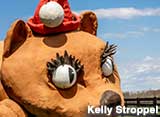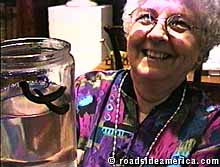
Pearson Museum
Springfield, Illinois
Barbara Mason, who we decide to call "The Leech Lady," was the curator and our entertaining host in 1998 at the Pearson Museum, which is similar in spirit to public medical exhibits such as the Mutter Museum in Philadelphia, PA. Although much smaller than the Mutter (or the National Museum of Health near Washington, DC) the Pearson Museum is still satisfying -- especially with Barbara around to point out the good stuff.
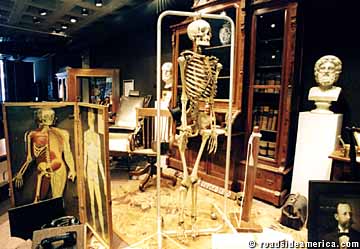
Barbara, longtime British subject, is petite, good-humored, speaking with a gentle Cambridge accent. She matter-of-factly opens her jar of frisky leeches("They get quite rambunctious when they smell blood.") and talks of the benefits of medicinal maggot use. "There was a gentleman in France who fell off his bicycle in a remote area and was terribly injured. It was several days before they found him, but when they did his wounds were healing nicely. No gangrene at all. It was the maggots, you see. They only eat dead tissue."
While we try, unsuccessfully, to knock the hungry leeches back into their refrigerator jar, Barbara tells us that she began as the assistant to the late Emmet F. Pearson, the doctor who founded this museum. He was born in a Tennessee log cabin and grew up to be an avid collector, tirelessly tracking down odd items he deemed medically significant. His collection of disinfected mail, now part of the museum, is probably the most extensive in the world (Until the mid-20th century, one way mail was routinely "disinfected" during disease outbreaks was by punching holes in the envelopes and leaving them for hours in railway boxcars filled with burning sulfur fumes.).
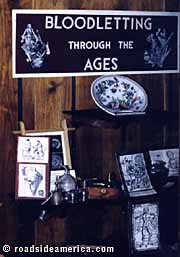
We nervously keep one eye on the leeches while Barbara shows us around. Most of Dr. Pearson's collection is in a large storeroom, and items are rotated in and out for museum theme exhibits. Right now there's a cabinet display titled "Bloodletting Through The Ages," another on historic treatments for the mentally ill, and medical illustrations of rods being inserted into penises and testicle surgery.
A human skeleton dangles from a rack. Nicknamed "Fritz," it reportedly belonged to an executed German thief, though he shows no evidence of capital punishment.
Barbara tells us she needed to find proof the skeleton was indeed German -- otherwise the museum might be accused of displaying a Native American skeleton, for which it would have to pay stiff fines. While Barbara tracked down the necessary papers, Emmet drove around with the skeleton in the trunk of his car for two weeks. "He was so old," she remembers. "I felt sure he'd be pulled over and the police would find Fritz and then we'd be in all sorts of trouble."
Barbara attempts to gently push a leech back into the jar with her handy cardboard "guest register" sign. Another leech immediately suctions onto it and starts to slink out of the jar. Barbara mentions that the leeches hit you with a natural anesthetic, which is why we won't notice them if they attach to us (Hours later, on the interstate, our skin crawls as we hallucinate escapees quietly drinking our blood).
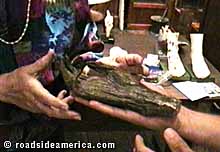
Mercury-soaked hand.
Barbara continues our whirlwind tour of Dr. Pearson's oddities: a bar of obesity soap (said to melt away fat), a set of wooden dentures carved by an Illinois farmer (taken from his mouth after he died), and a replica of a Roman brass urinal. She walks to an innocent-looking table top and comes back with a mummified human hand, which reminds us of the mummified human arm we saw in Sharpsburg, MD. This one is wrapped in a baggie because it's full of mercury, and visitors are not allowed to touch it. We insist on appraising the hand -- after all, we are "experts." "Feel it -- it's like a piece of bronze," she says, sliding the deadly appendage into our hands. It sure is heavy, and completely safe to touch. Still, feeling vaguely contaminated, we realize it's time to go.
The Pearson Museum doubles as a meeting room for the medical school, so there's no guarantee you can get in if you just show up. We suggest you call first. And if you do visit, pack a pair of surgical gloves and keep Barbara away from the refrigerator.
Update - July 2007: Sadly, Barbara Mason is reported to have passed away "about two years ago." Her replacement is "not a new Leech Lady."




